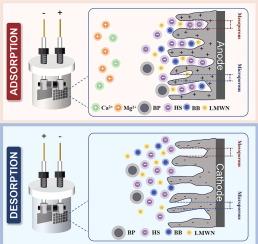介孔活性炭纤维施加正电位增强煤化工膜精矿中有机物的吸附
IF 9
1区 工程技术
Q1 ENGINEERING, CHEMICAL
引用次数: 0
摘要
在煤化工中,反渗透浓缩物中有机物的高效脱除是保证蒸发结晶装置零排液过程稳定运行和结晶盐纯度的关键。活性炭吸附是一种简单有效的方法;但其吸附动力学慢,再生能量要求高,限制了其广泛应用。为此,我们制备了具有高比表面积的介孔活性炭纤维(ACF)作为电极材料,并通过施加电势来增强有机物的吸附和解吸。ROC中的有机物主要由带负电荷的腐殖质和低分子量中性组成。与ACF吸附或负电位吸附相比,施加正电位对介孔ACF吸附有机物的量和速率分别显著提高30%和90%。这种增强归因于ACF的静电吸引和介孔结构。具有高介孔体积的ACF对腐殖质、低分子量中性物和构建块具有良好的去除效果。相关分析表明,吸附速率主要与介孔有关。通过对负载有机物的ACFs施加反向电位,40-70%的吸附有机碳在5 min内被解吸回水中。活性炭吸附有机物的解吸能耗比活性炭的解吸能耗低近3个数量级。本研究为提高对ROC中有机物的吸附提供了一种新的解决方案。本文章由计算机程序翻译,如有差异,请以英文原文为准。


Enhanced adsorption of organic matter from coal chemical membrane concentrate by applying positive potential to mesoporous activated carbon fiber
Efficient removal of organics from reverse osmosis concentrate (ROC) in the coal chemical industry is crucial for ensuring the stable operation of the evaporation-crystallization unit within zero liquid discharge process and the purity of the crystallized salt. Activated carbon adsorption is a straightforward and effective method; however, its slow adsorption kinetics and high regeneration energy requirements limit its broader application. Herein, we prepared mesoporous activated carbon fiber (ACF) with high specific area as electrode material, and enhanced the adsorption and desorption of organics by applying an electric potential. The organics in the ROC is primarily composed of humics, which are negatively charged, and low molecular weight neutrals. Applying a positive potential to the mesoporous ACF significantly increased the adsorption amount and rate of organic matter by 30% and 90%, respectively, compared to ACF adsorption or adsorption with a negative potential. This enhancement was attributed to the electrostatic attraction and mesoporous structure of ACF. ACF with high mesopore volume showed good removal of humics, low molecular weight neutrals and building blocks. Correlation analysis revealed that the adsorption rate was predominantly linked to the mesopores. By applying the reverse potential to the ACFs loaded with organic matter, 40–70% of the adsorbed organic carbon was desorbed back into the water within 5 min.The energy consumption for desorption of organics adsorbed by ACFs was almost three orders of magnitude lower than that for GAC desorption. This study offers a novel solution for enhancing the adsorption of organic matter from ROC.
求助全文
通过发布文献求助,成功后即可免费获取论文全文。
去求助
来源期刊

Separation and Purification Technology
工程技术-工程:化工
CiteScore
14.00
自引率
12.80%
发文量
2347
审稿时长
43 days
期刊介绍:
Separation and Purification Technology is a premier journal committed to sharing innovative methods for separation and purification in chemical and environmental engineering, encompassing both homogeneous solutions and heterogeneous mixtures. Our scope includes the separation and/or purification of liquids, vapors, and gases, as well as carbon capture and separation techniques. However, it's important to note that methods solely intended for analytical purposes are not within the scope of the journal. Additionally, disciplines such as soil science, polymer science, and metallurgy fall outside the purview of Separation and Purification Technology. Join us in advancing the field of separation and purification methods for sustainable solutions in chemical and environmental engineering.
 求助内容:
求助内容: 应助结果提醒方式:
应助结果提醒方式:


